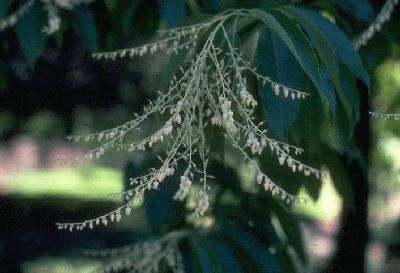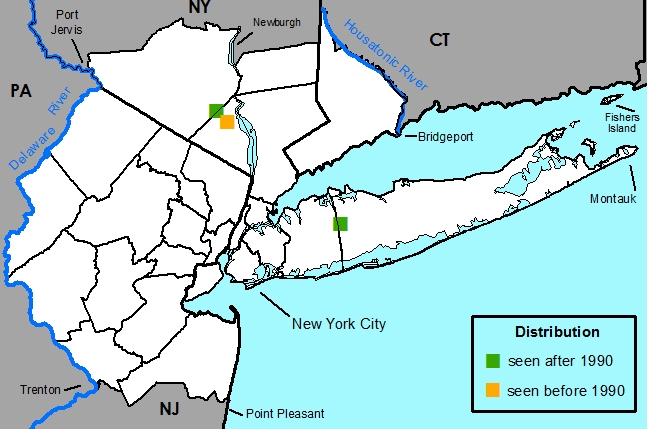Oxydendrum arboreum (L.) DC. - Sourwood

Sourwood
Photo © Peter Nelson, 1984, taken at the Brooklyn Botanic Garden.
Common Names
SourwoodField Identification
A small tree with elliptic or lanceolate leaves and large drooping panicles of small vase-shaped flowers.Medicinal uses
Disclaimer: The information provided here is for reference and historical use. We do not recommend nor do we condone the use of this species for medicinal purposes without first consulting a physician.(Hare et al., 1905) (Uphof, 1968)
The leaves, known as "Folia Andromedae" or "Elk Tree Leaves", contain andromedotoxin and have been used to treat cardiac ailments, as a diuretic, and are chewed to allay thirst.
Common names
Arrow-Wood
Lily-of-the-Valley Tree
Sorrel-Tree
Sourgum
Sourwood
Titi
Nomenclature
*Andromeda arborea L., Sp. Pl. 1: 394. 1753. *Oxydendrum arboreum (L.) DC., Prodr. 7(2): 601. 1839. *Lyonia arborea (L.) D. Don, Edinburgh New Philos. J. 17: 159. 1834. TYPE: Type not designated, at least two elements.Description
HABIT perennial, deciduous, phanerophyte, trees, autotrophic, monoclinous, with fibrous roots, 4-5(-25) m tall, not modified.STEMS erect, round, not winged, "regular". Prickles absent. Bark plated, not exfoliating, dark gray. Branches ascending to decumbent, dark gray, round, not winged, 5-100 mm in diam. Twigs light yellowish green or dark red, not odoriferous, round, 2-4 mm in diam., smooth, glabrous, without glands. Pith present, white, round, continuous, nodal diaphragm absent. Thorns absent. Aerial roots absent. Sap translucent. Resin absent.
BUDS terminal buds absent. Axillary buds present, 1, very widely ovoid, 1.5-2 mm long, blunt. Bud scales 3, dark orange-red or dark reddish orange, imbricate, ovate, chartaceous, obtuse, glabrous, without glands. Leaf scars obdeltate, 1.2-2.2 mm high, 1.8-2.1 mm wide, none. Vascular bundle scars 1, circular, 0.5-1 mm tall.
LEAVES alternate, 1 per node, spaced evenly along stem, divergent from stem, simple. Stipules absent. Leaves petiolate, petiole "typical", 0.5-2 cm long, hairs short and unbranched and hairs long and unbranched, erect (long hairs) or spreading (short hairs), multicellular (long hairs) or unicellular (short hairs), multiseriate (long hairs) or uniseriate (short hairs), sparse (long hairs) or moderately dense (short hairs), throughout, not glabrescent, without glands. Leaf: abaxial surface dark green, adaxial surface dark green, blades narrowly elliptic or lanceolate or elliptic or ovate, plane, symmetric, 8-16 cm long, 2.5-4.5 cm wide, coriaceous, base cuneate, margin denticulate, apex acuminate, abaxial surface hairs long and unbranched, erect or spreading, multicellular, multiseriate, light orange-yellow, sparse, along midveins, not glabrescent, without glands, adaxial surface hairs short and unbranched, erect or spreading, multicellular, multiseriate, light orange-yellow, sparse, along midveins, glabrescent, without glands. Brochidodromous venation, veins 8-13. Leaf lobes absent. Spines absent. Tendrils absent.
INFLORESCENCES monomorphic, regular or, if dimorphic, female inflorescence simple, panicle, terminal. Peduncle present, 0.5-4 cm long. Rachis present, 5.5-20 cm long, with bracts. Bracts sessile, blades: abaxial surface light orange-yellow, adaxial surface light orange-yellow, lanceolate or ovate, plane, 1.2-1.9 mm long, 0.5 mm wide, base truncate, margin ciliate, apex acuminate to acute, abaxial surface hairs short and unbranched, abaxial hairs appressed or spreading, unicellular, uniseriate, white or light gray, dense, throughout, not glabrescent, without glands, adaxial surface hairs short and unbranched, appressed or spreading, unicellular, uniseriate, white or light gray, dense, throughout, not glabrescent, without glands. Pedicel 2.5-5 mm long, hairs short and unbranched, hairs appressed, unicellular, uniseriate, white or light gray, dense, throughout, not glabrescent, without glands. Bracteoles 2, sessile, at midpedicel, not connate, bracteoles: abaxial surface light red or light orange-yellow, bracteole: adaxial surface light red or light orange-yellow, ovate, curved, 0.7-0.9 mm long, 0.4-0.5 mm wide, base truncate, margin entire, apex acuminate. Cupules absent.
FLOWERS serotinous, formed on long shoots, monomorphic, with sepals and petals readily distinguishable from one another, bisexual, flowers white, 5-merous, 5.5-5.6 mm long, 3.3-4.6 mm wide, 140-240 flowers per inflorescence, perianth of two whorls. Calyx present, actinomorphic, acetabuliform, of free sepals, persistent, abaxial and adaxial surfaces the same color, white or light orange-red, 1.6-2.5 mm long, 2.2-3.1 mm wide. Sepals or sepal lobes 5, ovate or widely ovate, 1.3-1.5(-2) mm long, 0.7-1.1 mm wide, base truncate, margin ciliate, apex acute, abaxial surface hairs short and unbranched, appressed, unicellular, uniseriate, white or light gray, moderately dense, throughout, not glabrescent, without glands, adaxial surface hairs short and unbranched, appressed or spreading, unicellular, uniseriate, white or light gray, sparse, throughout, not glabrescent, without glands. Epicalyx absent. Corolla present, actinomorphic, urceolate, of fused petals, deciduous, abaxial and adaxial surfaces the same color, white, uniform, 4.7-5.1(-8) mm long, 3.2-4.4 mm wide, corolla limb 1-1.2 mm long, 2.7-3.2 mm wide. Petals or petal lobes 5, "normal", triangular, 1-1.2 mm long, 0.7-1.2 mm wide, base truncate, margin entire, apex acute, abaxial surface hairs short and unbranched, appressed, unicellular, uniseriate, white, moderately dense, throughout, not glabrescent, without glands, adaxial surface glabrous, without glands. Gynoecium syncarpous. Carpels 5. Stigmas 1, truncate. Styles persistent, 1, 3-3.6 mm long. Ovary superior, 1.3-2 mm long, 1.2-2 mm wide, nectiferous disk present. Locules 5. Placentation basal. Androecium obdiplostemonous. Stamens 10, 3.6-4.9 mm long. Anthers linear, opening along the long axis, opening 1/2 of entire anther, bithecal, light orange-yellow, glabrous, Filaments free, S-curved, dark red or dark reddish violet or dark violet-red, hairs short and unbranched, erect, unicellular, uniseriate. Staminodes absent.
FRUITS loculicidal capsules, dark orange-red or yellowish orange, narrowly lanceoloid, (4-)5.5-7(-10) mm long, (2.5-)3.1-4 mm wide, hairs short and unbranched, appressed, unicellular, uniseriate, white or light gray, moderately dense, throughout, not glabrescent, without glands.
SEEDS many, orange-yellow, fusiform, 2-2.5 mm long, 0.2-0.4 mm wide, wingless, tailed, lineate.
Habitat
(Wherry, 1920)Mixed oak woods and roadsides, in dry upland peat. The soil mediacid to subacid.
Species Biology
FloweringUnknown.
Pollination
Unknown.
Fruiting
August [week 1] - October [week 2].
Dispersal
Unknown.
Germination
Unknown.